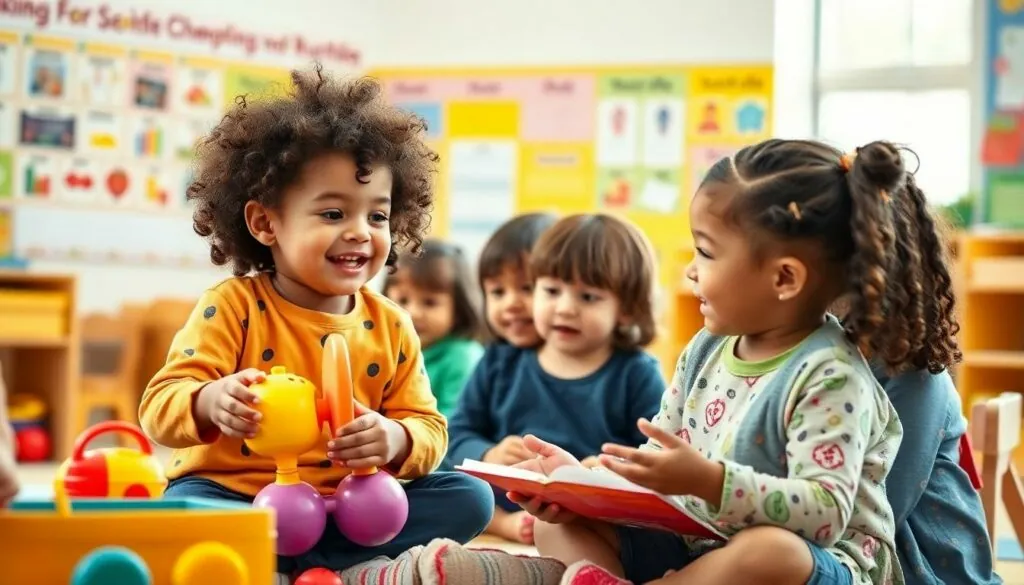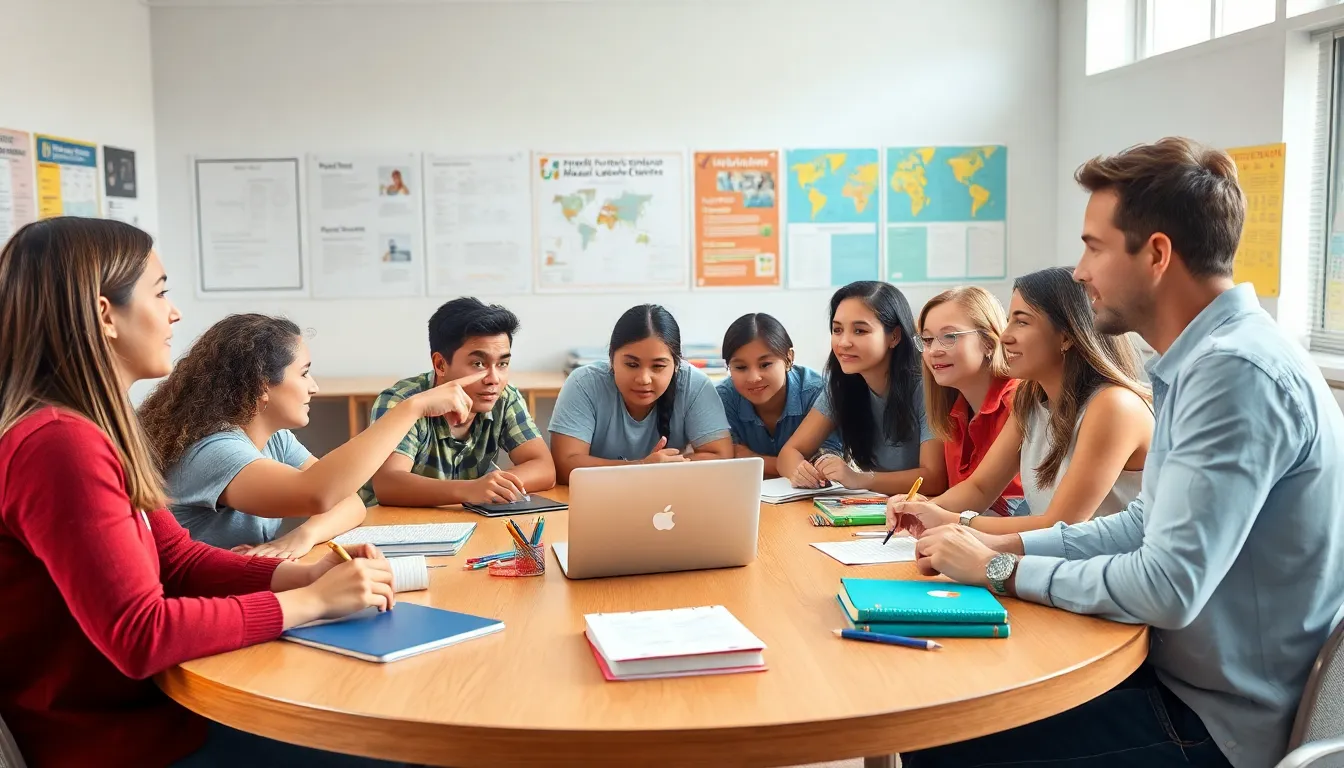In a world overflowing with language theories, gestalt language learning stands out like a unicorn at a horse race. This unique approach flips the script on traditional language acquisition, showing that kids can learn language in chunks, not just word by word. Imagine your child reciting movie quotes or song lyrics with the same enthusiasm as a toddler at a cookie factory—it’s not just cute, it’s a powerful learning tool!
Gestalt language learners take in phrases and whole sentences, piecing them together like a jigsaw puzzle. This method not only fosters creativity but also helps children communicate more effectively. So, if you’re ready to explore the fascinating realm of gestalt language learning, buckle up! It’s time to dive into a world where language is not just a skill but an adventure waiting to unfold.
Table of Contents
ToggleOverview of Gestalt Language Learning
Gestalt language learning represents a unique approach to language acquisition. Children engage with language by learning multi-word phrases before they master singular words. This method breaks away from traditional language learning techniques, encouraging learners to grasp communication in larger contexts. For instance, one child might repeat a favorite line from a movie as a way to express excitement, reflecting their understanding of language as a cohesive whole.
Learners often utilize scripts or echolalic phrases, which serve as building blocks for their communication. These phrases enable them to convey thoughts and feelings, allowing for creativity in expression. Observing a child using phrases from familiar contexts illustrates their progress and understanding.
He or she begins with chunks of language, gradually understanding how to combine them in novel ways. Communication grows from a reliance on imitation to the ability to create new sentences. Children often transition from gestalt language learners to more analytical language users as they develop.
This method encourages play and exploration, fostering a natural language development experience. Through interactions with caregivers and peers, language acquisition flourishes. Engaging in meaningful exchanges helps solidify understanding and application of language skills. Tools such as visual supports and modeling further enhance this learning process.
Gestalt language learning focuses on the holistic nature of language, leading to enriched communication capabilities. This approach invites both learners and their supporters to embrace the journey of language development.
Key Principles of Gestalt Language Learning

Gestalt language learning relies on specific foundational principles that support effective communication development.
Whole-to-Parts Approach
The whole-to-parts approach emphasizes understanding language as a complete unit rather than as isolated words. This strategy allows children to initially absorb phrases and sentences in context. For example, a child might repeat “Let’s go outside” without deconstructing individual words. This method serves as a crucial building block, encouraging the child to internalize chunks of language that eventually lend themselves to creative expression. As learners gain familiarity with various phrases, they transition towards forming new, original sentences. This gradual shift fosters independent language use and broadens their communicative abilities.
Importance of Context
Context plays a vital role in gestalt language learning. Children pick up language from their environment, associating phrases with specific situations. Engaging in meaningful interactions boosts comprehension and recall. For instance, when a child hears a parent say, “Dinner is ready” during mealtime, they connect that phrase with food and family gatherings. This contextual understanding enhances their ability to use learned phrases appropriately. Recognizing contexts also aids in transitioning from echolalic speech to more nuanced language applications. Ultimately, prioritizing context enriches the child’s linguistic experience and fosters deeper communication skills.
Stages of Gestalt Language Learning
Gestalt language learning progresses through distinct stages, each vital for developing comprehensive communication skills.
Echolalia as a First Step
Echolalia often serves as the initial stage of gestalt language learning. In this phase, children repeat phrases or sentences they’ve heard, showcasing their ability to acquire language in chunks. For instance, a child might echo lines from favorite shows, highlighting their understanding of communication as a whole. This repetition helps solidify auditory memory and builds a foundation for later language use. Observing this phase allows caregivers to recognize the child’s emerging language patterns. Embracing echolalia fosters creativity in expression, forming a critical part of their linguistic journey.
Moving Toward Generative Language
Moving beyond echolalia marks a significant transition in language development. Children start to generate their own original sentences, using phrases as templates. During this stage, they mix elements from previously learned phrases to communicate novel ideas. For example, they might combine familiar phrases to express unique thoughts or feelings. This shift signals a deeper understanding of language structure and context. Engaging with caregivers through open-ended questions and prompts encourages this generative process. Supporting this stage empowers children to gain more control over their communication.
Benefits of Gestalt Language Learning
Gestalt language learning presents numerous advantages for children acquiring language skills. Enhanced communication abilities arise from the natural method of learning phrases and sentences. Learners experience an immediate boost in confidence while expressing ideas using familiar multi-word chunks.
Creativity flourishes through the use of scripts and echolalic phrases. Children often combine these phrases in novel ways, allowing personalized expression. Furthermore, the whole-to-parts approach enables deeper understanding of language contexts. By connecting phrases to specific situations, children build associations that strengthen memory recall.
Social interactions benefit greatly through meaningful communication opportunities. Caregivers engaging with children during play help facilitate authentic language use. Open-ended questions encourage exploration and promote generative language development.
The learning process also supports cognitive growth. Children develop problem-solving skills as they navigate language use and adapt phrases creatively. This adaptability prepares them for various conversational contexts.
Progressing through the stages of gestalt language learning reinforces structure awareness. Children transition from echolalic speech to original sentence construction, highlighting their linguistic development. Through practice, their vocabulary expands naturally, increasing their capacity for nuanced expression.
Visual supports and modeling enhance the learning experience. Tools like visual aids help solidify understanding and guide language use in different scenarios. These resources provide additional context, further enriching the communication process.
Overall, gestalt language learning cultivates a holistic understanding of language, resulting in profound communication skills and deeper connections with peers and caregivers.
Strategies for Supporting Gestalt Language Learners
Supporting gestalt language learners involves various strategies that enhance their language acquisition journey. These strategies focus on creating enriching environments and interactive experiences.
Environmental Supports
Environmental supports play a vital role in facilitating language development. Providing a language-rich environment helps children absorb meaningful phrases. Picture schedules, labels, and visual aids create context for communication. Familiar settings encourage children to use language in a way that feels natural. Structured routines enable them to anticipate activities, strengthening their comprehension. Visual supports help children connect phrases to specific actions. Immersing learners in engaging materials fosters curiosity and creativity. Creating spaces where children feel safe to express themselves amplifies their confidence.
Interactive Play Techniques
Interactive play techniques enhance language learning through engaging experiences. Encouraging turn-taking during play promotes communication as children practice using phrases. Incorporating role-playing scenarios allows learners to experiment with familiar scripts. Playing games that require verbal interaction stimulates their vocabulary growth. Open-ended questions during play invite children to generate original sentences, fostering creativity. Modeling how to incorporate new words into familiar phrases enriches their language toolkit. Utilizing songs and rhymes introduces rhythmic patterns, aiding memory retention. Collaborative storytelling encourages sharing and enhances narrative skills, supporting overall language development.
Gestalt language learning offers a refreshing perspective on how children acquire language. By focusing on phrases and multi-word chunks, it nurtures creativity and enhances communication skills. This approach not only fosters a deeper understanding of language but also encourages meaningful interactions between children and their caregivers.
As children navigate through the stages of gestalt language learning, they develop confidence and problem-solving abilities. The transition from echolalic speech to original sentence construction marks a significant milestone in their linguistic journey. Embracing this method opens doors to richer social connections and more effective self-expression.
Ultimately, gestalt language learning is an adventure that equips children with the tools they need for effective communication, paving the way for lifelong language development.






